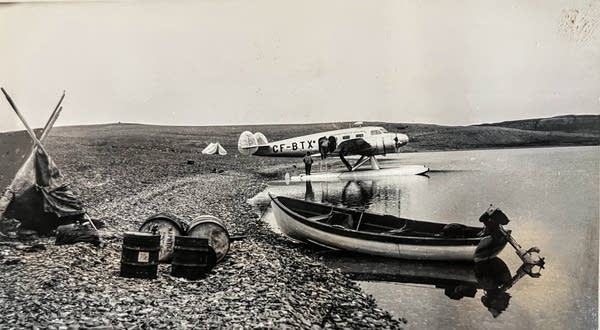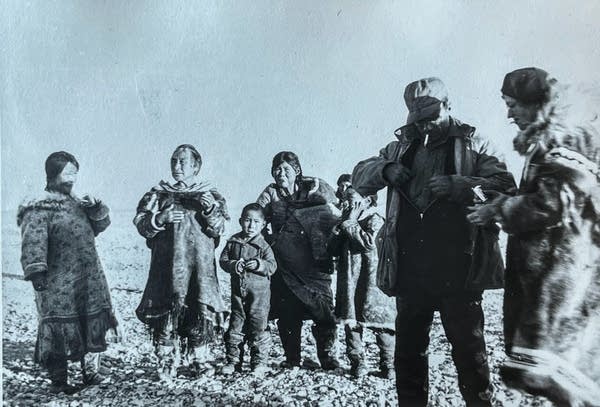Work of pioneering Arctic explorer from Minnesota gains new relevance in tracking effects of climate change

Go Deeper.
Create an account or log in to save stories.
Like this?
Thanks for liking this story! We have added it to a list of your favorite stories.
Many people know the University of Minnesota’s Bell Museum for its dioramas and the massive woolly mammoth in its main exhibit hall. But it is also home to a giant herbarium — a collection of nearly a million plant specimens collected from all over the world.
And amid those vast holdings are hundreds of specimens collected by a peripatetic, boot-clomping, chain-smoking librarian who grew up near Duluth and blazed a trail across the Arctic starting before World War II.
Margaret Oldenburg “was an early pioneer in a way,” said Tim Whitfeld, collections manager for the Bell Museum herbarium. “She was one of the first collectors who focused her attention on the arctic flora of Canada.”
And while she died a half-century ago, Oldenburg's carefully documented specimens are finding new relevance today. Canadian researchers have been traveling to Minnesota to view Oldenburg's work and use it to better understand the effects of the changing climate.
Turn Up Your Support
MPR News helps you turn down the noise and build shared understanding. Turn up your support for this public resource and keep trusted journalism accessible to all.

Raised near Jay Cooke State Park
Margaret Oldenburg was a child of privilege. Born in 1892, she was the daughter of Henry Oldenburg, a lawyer for the Weyerhaeuser lumber empire. She grew up in a sprawling yellow brick mansion on the outskirts of Carlton, Minn.
Her backyard was Jay Cooke State Park, which her dad helped create. The park’s Oldenburg Point, one of the most stunning vistas in Minnesota, was named in his honor.

After graduating from Carlton High School, Oldenburg got her first bachelor’s degree from Vassar College in 1915, in German and physics. She got a teaching degree from the University of Minnesota in 1921 and taught science in Coleraine, Jordan, Northfield, Hibbing and Chisholm. Her papers include snapshots from canoe trips with her father in the Boundary Waters, as well as journeys around the world.
In 1929, she got her third bachelor’s degree, again from the U of M, and went to work for the next 10 years at Walter Library on the Minneapolis campus, as a cataloger.
Then, things got interesting.
In 1939, Oldenburg read “Vagabond Voyaging,” a book about leisure travel by freighter. Weeks later she quit her job at the U of M, squeezed onto the Hudson’s Bay Company icebreaker Nascopie, got off the boat in Churchill, Manitoba and headed onto the tundra.
Roaming the Canadian Arctic
She roamed along the Mackenzie River, across the Northwest Territories and north of the Arctic Circle, by ship, dog sled, canoe, fishing boat and eventually by floatplane — crammed amid boxes of puppies, sacks of coal and bales of furs. At every stop, the same mission: pick up plants and soil samples, recording the exact location of every specimen.
As she described it in her written memoirs:
“All of my trips ashore followed the same pattern: a frantic scurrying about to try and find every kind of flower, grass and moss and lichen, picking up stones as I went.”

Oldenburg wasn't formally a researcher at the university. She worked, apparently as an unpaid volunteer, for the U of M’s botany department.
“Well, she was a librarian — so maybe in her nature, she was a cataloger, and collector of things,” the Bell Museum's Whitfeld said. “And she was an enthusiastic amateur botanist as well. Self-taught.”
Oldenburg collected thousands of samples. She pressed them in boxes and brought them back to Minnesota — packed next to ship boilers to dry them on the way. Back home, she would glue them to archive paper, with business card-sized maps and notes, pinpointing their original location.

Oldenburg also sent boxes of specimens to the Canadian Museum of Nature — like Canada’s Smithsonian. Paul Sokoloff is a botanist there.
“We have the National Herbarium of Canada, which like the Bell Museum herbarium is a collection of pressed and dried plants and algae, lichens, mosses, etcetera,” he said. “And in that we have a backlog of specimens ... that we haven't been able to process. And in going through that we found 5,000 specimens collected in the Canadian Arctic by Margaret Oldenburg.”
That discovery recently brought Sokoloff to the Bell Museum, to document her trove in Minnesota and see what else she collected.
“In going through those specimens, we're able to tell a lot about the biodiversity of the most rapidly changing ecosystem on the planet,” Sokoloff said.

And Margaret Oldenburg’s years of dogsledding, lake hopping and meticulous documentation help mark that change. She left a snapshot of Arctic Canada's plant life, now nearly a century old.
"We can actually go back in time,” Sokoloff said, “and see, well, where have plants been — and are their distributions and ranges changing now?”
Devotee of the Arctic
All told, Oldenburg made 11 trips to northern Canada through 1952. Oldenburg occasionally stayed into winter, at least once skipping the “Christmas plane” headed home. She helped publish a newspaper, served as a village nurse during a flu epidemic in the 1940s and collected and published a widely circulated collection of Inuit recipes — meant, she said, for people who could only shop for groceries once a year, when the supply boat arrived.
Oldenburg had a fraught relationship with Canadian First Nations. She was described as the first white woman to travel through Canada north of the Arctic Circle. Indigenous Canadians helped her collect plants and guided her across thousands of miles of tundra, and she expressed repeated admiration for their hospitality and resourcefulness. But she wrote, as well, of a common habit of visiting villages and throwing handfuls of candy on the ground to watch the residents, young and old, scramble to pick it up.

Oldenburg was an unfaltering devotee of the Arctic itself, boasting she lived with a single parka, lumberjack shirt, wolf fur mittens and pair of ski pants, and liked it that way. Even back home in Minnesota, she used a Native sealskin bag for her luggage.
“There is something about the Arctic,” she told the Minneapolis Tribune about her travels in 1951. “It’s so absorbing, and I do love flat country.”
She said she preferred to travel alone and was once listed as “lost” by a Duluth newspaper reporting an Arctic aircraft mishap, which she survived.

Later years
Her real end was more bittersweet: By the mid-1950s, she was struggling to hear and stopped traveling.
Oldenburg eventually moved back to Minneapolis and worked on her collections at the U of M. Her correspondence with friends seems to have trailed off to occasional Christmas cards. She never married, never had children, never made any reference to a partner or close relationship in the letters she left behind, other than a Canadian pilot friend and his wife. She passed away at age 80 in 1972, found dead and alone in her room in a $15 a week flophouse hotel just outside downtown Minneapolis.
Mimeograph copies of her tales of adventure, with random notes, snapshots and keepsakes, fill a single cardboard box in the U of M archives. A newspaper clipping, framed in tribute, hangs in what used to be her bedroom in her childhood home in Carlton.

Emily Swanson runs the bed and breakfast at what is now called the Oldenburg House. Swanson's husband Glenn’s family bought the place long after Oldenburg’s mother died and Margaret sold off the family home in 1931. The Swanson’s have a collection of Margaret's letters, and Emily said a childhood friend stopped by years ago to share memories of Margaret.
“She loved the symphony, ballet, art museums, to travel. Very well-educated and curious. She was here as a young woman, and I know had a place in Grand Marais. My sense was that she had a light footprint, after she grew up and went away to school,” Swanson said.

Oldenburg is buried next to her parents, and a brother who died at age 8. Her resting place is on top of the slope at Hillside Cemetery in her hometown of Carlton. A life of adventure, come full circle back to that corner of northern Minnesota — and a legacy that lives on in research about the changing world today.



